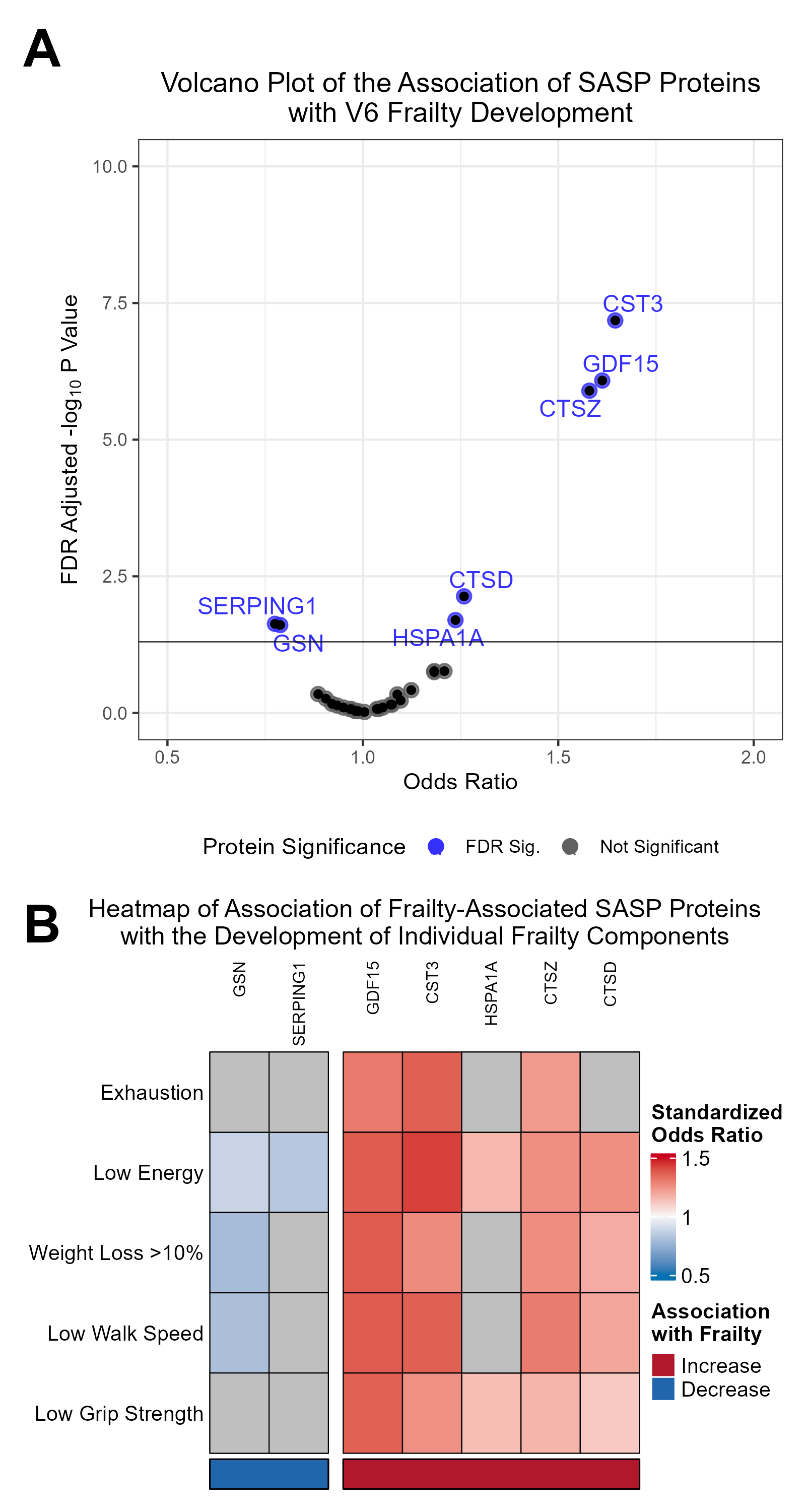Final ID: P2101
Association of circulating senescence-associated secretory phenotype (SASP) proteins with the development of frailty in late-life: the Atherosclerosis Risk in Communities (ARIC) Study
Abstract Body: Introduction Emerging evidence suggests a role for cellular senescence in the pathogenesis of adverse late-life outcomes including frailty. Senescence-associated secretory phenotype (SASP) is a hallmark of senescent cells, but the extent to which circulating SASP protein levels associate with the development of frailty is not known.
Hypothesis: Circulating markers of cellular senescence, reflected in the SASP, will associate with greater risk of developing frailty in late life.
Methods We studied 2,359 older adults in the community-based Atherosclerosis Risk in Communities (ARIC) cohort study who were free of HF and frailty at study Visit 5 (2011-13), had large-scale aptamer proteomics (SomaScan) measured at Visit 5, and had frailty assessed at study Visit 6 (2016-17). Protocol assessments of frailty were performed at each study visit using the Fried criteria. We assessed the association of 29 aptamers representing 26 unique SASP proteins at Visit 5 with incident frailty and frailty components at Visit 6 using multivariable logistic models adjusted for age, sex, race, and visit center. Two-sample cis-Mendelian randomization (cis-MR) was performed to evaluate potential causal effects of proteins on frailty.
Results Mean age at Visit 5 was 74±5 years, 57% were women, and 16% reported black race. Over the 5 years between Visits 5 and 6, 152 participants developed frailty. Seven of 26 SASP proteins were associated with the development of frailty at FDR significance (FDR-adjusted p < 0.05 ; Figure): five with higher risk of frailty (CST3, GDF15, CTSZ, CTSD, HSPA1A) and two with lower risk (GSN, SERPING1). These proteins demonstrated the most consistent associations with low energy, while GDF15, CST3, and CTSZ were significantly associated with all five frailty components (FDR-adjusted p < 0.05). In cis-MR analysis, GDF15 and SERPING1 showed potential causal effects on frailty.
Conclusion Higher circulating levels of a subset of senescence-associated proteins are associated with greater risk of developing frailty in late life, two of which may have causal effects on frailty. These findings support a potential role for cellular senescence in the pathogenesis of the frailty syndrome.
Hypothesis: Circulating markers of cellular senescence, reflected in the SASP, will associate with greater risk of developing frailty in late life.
Methods We studied 2,359 older adults in the community-based Atherosclerosis Risk in Communities (ARIC) cohort study who were free of HF and frailty at study Visit 5 (2011-13), had large-scale aptamer proteomics (SomaScan) measured at Visit 5, and had frailty assessed at study Visit 6 (2016-17). Protocol assessments of frailty were performed at each study visit using the Fried criteria. We assessed the association of 29 aptamers representing 26 unique SASP proteins at Visit 5 with incident frailty and frailty components at Visit 6 using multivariable logistic models adjusted for age, sex, race, and visit center. Two-sample cis-Mendelian randomization (cis-MR) was performed to evaluate potential causal effects of proteins on frailty.
Results Mean age at Visit 5 was 74±5 years, 57% were women, and 16% reported black race. Over the 5 years between Visits 5 and 6, 152 participants developed frailty. Seven of 26 SASP proteins were associated with the development of frailty at FDR significance (FDR-adjusted p < 0.05 ; Figure): five with higher risk of frailty (CST3, GDF15, CTSZ, CTSD, HSPA1A) and two with lower risk (GSN, SERPING1). These proteins demonstrated the most consistent associations with low energy, while GDF15, CST3, and CTSZ were significantly associated with all five frailty components (FDR-adjusted p < 0.05). In cis-MR analysis, GDF15 and SERPING1 showed potential causal effects on frailty.
Conclusion Higher circulating levels of a subset of senescence-associated proteins are associated with greater risk of developing frailty in late life, two of which may have causal effects on frailty. These findings support a potential role for cellular senescence in the pathogenesis of the frailty syndrome.
More abstracts on this topic:
Administration of the Recombinant Activated Protein C Rescues the Cardiac Vulnerability to Ischemic Insults in Aging through Modulating Inflammatory Response during Ischemia and Reperfusion
Slotabec Lily, Rouhi Nadiyeh, Seale Blaise, Wang Hao, Filho Fernanda, Adenawoola Michael, Li Ji
Association of Cardiopulmonary Resuscitation Strategies with Diffuse Optical Measurements of Cerebral HemodynamicsAnderson Darci, Gaudio Hunter, Morton Sarah, Menezes Forti Rodrigo, Baker Wesley, Kilbaugh Todd, Morgan Ryan, Ko Tiffany, Herrmann Jeremy, Senthil Kumaran, Crozier Aidan, Mason Mckenna, Seeney Alyssa, Ranieri Nicolina, Goto Rika, Krishna Akshatha

